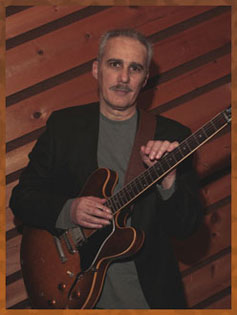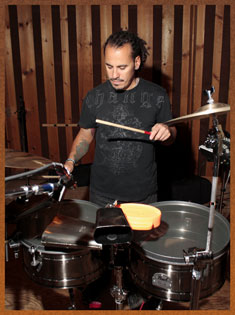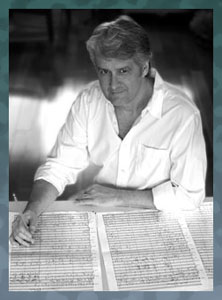|
Steve
Khan's
lead
sheet:
"When She's Not Here"(Steve Khan)
"When She's Not Here" is "the ballad" of the recording, and it is performed with the Latin bolero rhythm as its foundation. My initial hope and concept was that Dennis Chambers could utilize his beautiful skills with brushes to give it a more elastic jazzy feel. I remember that, when we ran through the tune at our rehearsals, and even as we prepared to record it late in the evening on November 6th, 2010, Dennis had exactly the right approach from my perspective. But, the performance that now graces the recording, which was the first and only take that we did, seems to be much more in an even 8th-note place. It still sounds beautiful to me, but when playing improvised music, you have to accept a performance if it captures the overall feeling that you were trying to convey. A few people, close friends, have told me that they hear the influence of Clare Fischer in this tune, and I could not be more pleased about anything, because, if his influence is there, it was purely unconscious. To me, this means that his harmonic style has now firmly rooted itself in my being. The changes are based upon one of my favorite standards.
 For those of you who have been following along with the story of the recording of "PARTING SHOT," you might recall that the first day of recording did not exactly go as I had hoped. Again, I had been hoping and planning that we could record 5 tunes that day. But, after the first 2 tunes had been recorded, "Change Agent" and "Chronology" I knew that my goal was in serious trouble. So, I decided that the most prudent thing to do would be to go after the tunes that would be the easiest to record after what had been a long and difficult day. So, a ballad definitely fits in with that goal. On the demo of this tune, just to fill out the texture, Rob Mounsey added in some really gorgeous string pads during the solo section, and I had gotten so used to hearing them that I decided that we would record live along with a pared down version of the demo. Just prior to recording the song, I sat at the computer with our assistant engineer, Rick Kwan, and quickly revised just where the string orchestration would enter, and where they would drop out. Once that was done, we were ready to record. Below, you can see just how the form, and the solo format was laid-out.
For those of you who have been following along with the story of the recording of "PARTING SHOT," you might recall that the first day of recording did not exactly go as I had hoped. Again, I had been hoping and planning that we could record 5 tunes that day. But, after the first 2 tunes had been recorded, "Change Agent" and "Chronology" I knew that my goal was in serious trouble. So, I decided that the most prudent thing to do would be to go after the tunes that would be the easiest to record after what had been a long and difficult day. So, a ballad definitely fits in with that goal. On the demo of this tune, just to fill out the texture, Rob Mounsey added in some really gorgeous string pads during the solo section, and I had gotten so used to hearing them that I decided that we would record live along with a pared down version of the demo. Just prior to recording the song, I sat at the computer with our assistant engineer, Rick Kwan, and quickly revised just where the string orchestration would enter, and where they would drop out. Once that was done, we were ready to record. Below, you can see just how the form, and the solo format was laid-out.
"When She's Not Here" also captures the best of the sense of Eyewitness music-making blended with everything that I have come to love so much about Latin music. To have written something with the specific intention that it would be a bolero is very gratifying for me. In a very open texture such as this, my favorite percussive touch, in this case coming from Dennis Chambers, is the usage of his 20" heavy flat-ride with rivets. As he touches that cymbal every so often, it is remarkable how that instrument, that cymbal, can fill out the space in the most beautiful way. I have always said to people, when asked, that a rivet cymbal, especially on a ballad, is like having strings present. That perspective, for me, has never changed, and this piece is a wonderful example of that. Dennis did a magnificent job with that color. Where colors are concerned, no one adds more wonderful touches than Manolo Badrena, his contributions, though very subtle, are as though someone had actually written them into the arrangement. Of course, they were all improvised.
Over the years, one of the things that I've learned about Latin music, and working with the great percussionists, is that one is not going to hear everything while you are actually recording. Whatever those other layers and colors might be, they will be recorded as an overdub, just after the take is done. On a bolero such as this one, I knew that Marc Quiñones would be playing the bongo afterward. After we had listened to the playback, my initial reaction was that, perhaps, there wasn't quite the rhythmic motion that I had expected in the Intro, [I], and so, Marc suggested the maracas, and on they went.
[I] - w/ String Orchestration
Melody Statement - Strings Drop Out
[A]
[A2]
[B]
[A3]
Solo Chorus 1
[A]
[A2]
[B]
[A3]
Solo Chorus 2
[A]
[A2]
[B] - Strings Enter
[A3]
Solo Chorus 3 | 1/2-Chorus
[A]
[A2]
Melody Returns - Strings Drop Out
[B]
[A3]
[Tag] - Strings Re-Enter
If you will allow me, I would love to sing the praises of the great Marc Quiñones! I cannot begin to tell you just how truly great Marc's musicianship and musicality are. He is spectacular in both areas. There are those who would find a ballad as being something that is not too much fun to play, but, if you listen really closely to Marc's contributions, anyone can tell that there is no end to the creativity one could apply. On the most simple of levels, on the master percussion charts that I wrote out for both Marc and Bobby Allende, there are a series of little accents that I wanted to Marc to catch. He executes all of these little touches with subtlety and precision. The other day, I was on the phone with Dennis Chambers, wishing him a
"HAPPY BIRTHDAY"(May 9th, 2011), and he specifically commented on just how much he was impressed with Marc's musicianship! He executes all of these little touches with subtlety and precision. The other day, I was on the phone with Dennis Chambers, wishing him a
"HAPPY BIRTHDAY"(May 9th, 2011), and he specifically commented on just how much he was impressed with Marc's musicianship!
Where listening and musicality are concerned, pay special attention to Marc's bongo playing throughout. That is the instrument that really reacts to and responds to the melody elements and, of course, the improvised solo. Marc played brilliantly throughout this piece. It is truly one of my favorite details. I've discussed, in a prior analysis, my panning concept for Latin percussion on this recording. However, the bolero percussion requires a slightly different approach. To be specific, the timbal remains on the left side of the mix. The bongo was placed hard to the right side. And, because of that, Bobby's conga was moved inside, to the left, a bit. If the panning knob can only go as far to the right as 5 o'clock, I would say that James Farber and I moved the conga to somewhere between 1 and 2 o'clock. This gives it some separation from the bongo. But, no matter how careful one is, on this tune, you can hear that when Dennis plays a backbeat with his brush on the snare drum, it obscures the slap from Bobby's conga. For me, this sonic/audio reality is most frustrating.
What is perhaps the very last detail in the arrangement, yes, the last bar came under some scrutiny at the rehearsal. Originally, I had written this to be played as two 8th-notes, which I would cue the first beat. But I guess that both Marc and Bobby didn't like the way that this felt, and so, they said to me, "Let's play it this way!" Well, "this way" actually meant that they wanted it to be 2 quarter-notes. Anthony and Dennis heard the change, and just played it correctly. Me? I couldn't figure out how what they were all playing could possibly have been interpreted as two 8th-notes. In the end, of course, I somehow played it correctly, though Marc never actually said to me, "Let's play it as 2 quarter-notes." I didn't actually understand what we had done until I had to adjust the lead sheet for this presentation. Once again, I could only laugh at myself for being so damn dense!!!
Going back a bit in time, as the composition and the arrangement slowly began to take shape, I thought that this might be a great opportunity to put the fantastic orchestration talents of Rob Mounsey on display. In the end, it is a bit of an insult to reduce such an orchestration to the more familiar term, at least amongst musicians, of "pads." The voicings, and the feeling that they create, are so warm and spectacular to me that, while listening to a final mix at the studio, when the strings re-entered during the 2nd Solo Chorus at [B], my eyes actually spontaneously welled-up with tears. This took me completely by surprise. The voicings, and the feeling that they create, are so warm and spectacular to me that, while listening to a final mix at the studio, when the strings re-entered during the 2nd Solo Chorus at [B], my eyes actually spontaneously welled-up with tears. This took me completely by surprise.
Though having an orchestration is almost antithetical to the usage of space and silence, which has become a "calling card" for Eyewitness, somehow, for this recording, these textures just seemed to make perfect sense to me. I hope that, for those who choose to listen, they will come to feel the same way. After the performance had been recorded, and Rob and I were involved in the labors of post-production, I came to feel that it would be wonderful if he could orchestrate the Intro, [I] as well. When he had completed this seemingly small task, I just could not believe how beautiful it now sounded. I had to ask him, "Man, what did you do?" And, Rob replied, "I just took the voicings that you had played, and then added an orchestral voice to them." Wow, that sure made me feel pretty good. Though I've said it here, at the site, before and many, many times, Rob Mounsey's musical talents and instincts are just in a zone where there are few peers. I have been so lucky to have had Rob as a close musical partner on these projects.
Over the years, at KHAN'S KORNER 1, I have offered a few Clare Fischer transcriptions, and on both of the first two solos, Clare was playing his beautiful Rhodes-styled keyboard over very transparent bolero feels. First there was "Once Again" and, sometime later, we presented "Gaviota," both are Clare's original compositions. If there was a musical feeling that I wanted to transmit through "When She's Not Here" while soloing, I suppose that, unconsciously, I would have wanted to sound just like Clare Fischer's Rhodes did on either of these two solos. I really do love the open texture of the Latin bolero feel. As the CD went out to radio in early May of 2011, I was fairly certain that this bolero, the ballad, would be one of the 6 most likely tunes to garner significant airplay at what remains of Jazz radio in the USA. As things turned out, and I don't know that I still understand exactly why, "When She's Not Here" placed dead last amongst the 10 tunes. Thelonious Monk's "Bye-ya" came in as the most played tune from the CD!
Not too long after the release of "PARTING SHOT," friends and acquaintances began to speculate as to just who the "she" in this title might be. Well, I can tell you that the inspiration for this ballad is not based upon any one singular female figure that has graced my life. It is simply a composite recollection of an idealized person more than a real one. As one arrives at this latter stage of life, there is always time, sometimes too much of it, to reflect on the women who have passed through one's experiences, and for many of these glorious women there will always exist a great sentimentality attached to those very special shared moments. For me, it matters not whether the parting of ways might not have been exactly as I would have desired, because the warmth of my feelings for them will always remain.
[Photos: Steve Khan; Marc Quiñones
by: Richard Laird @ Avatar Studio 'A' - November 6th, 2010
Photo: Rob Mounsey by Paul Mounsey]
|


 For those of you who have been following along with the story of the recording of "PARTING SHOT," you might recall that the first day of recording did not exactly go as I had hoped. Again, I had been hoping and planning that we could record 5 tunes that day. But, after the first 2 tunes had been recorded, "Change Agent" and "Chronology" I knew that my goal was in serious trouble. So, I decided that the most prudent thing to do would be to go after the tunes that would be the easiest to record after what had been a long and difficult day. So, a ballad definitely fits in with that goal. On the demo of this tune, just to fill out the texture, Rob Mounsey added in some really gorgeous string pads during the solo section, and I had gotten so used to hearing them that I decided that we would record live along with a pared down version of the demo. Just prior to recording the song, I sat at the computer with our assistant engineer, Rick Kwan, and quickly revised just where the string orchestration would enter, and where they would drop out. Once that was done, we were ready to record. Below, you can see just how the form, and the solo format was laid-out.
For those of you who have been following along with the story of the recording of "PARTING SHOT," you might recall that the first day of recording did not exactly go as I had hoped. Again, I had been hoping and planning that we could record 5 tunes that day. But, after the first 2 tunes had been recorded, "Change Agent" and "Chronology" I knew that my goal was in serious trouble. So, I decided that the most prudent thing to do would be to go after the tunes that would be the easiest to record after what had been a long and difficult day. So, a ballad definitely fits in with that goal. On the demo of this tune, just to fill out the texture, Rob Mounsey added in some really gorgeous string pads during the solo section, and I had gotten so used to hearing them that I decided that we would record live along with a pared down version of the demo. Just prior to recording the song, I sat at the computer with our assistant engineer, Rick Kwan, and quickly revised just where the string orchestration would enter, and where they would drop out. Once that was done, we were ready to record. Below, you can see just how the form, and the solo format was laid-out.